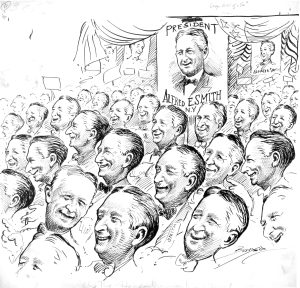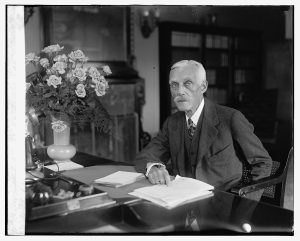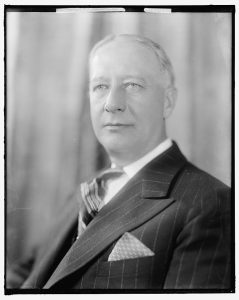
We tend to project our own assumptions about party positions onto events long past. For example, we assume that Democrats always advocated for increased government spending, at least more so than Republicans. Just how wrong such assumptions may be becomes clear when examining the Calvin Coolidge Papers, recently digitized and made available by the Library of Congress.
The documents involve the 1928 presidential campaign—and a high-stakes political fight. The contest started on the evening of October 11th when the voice of Treasury Secretary Andrew Mellon cut across the United States’ airwaves. Mellon, speaking over a national radio hook-up, endorsed the presidential candidacy of fellow Republican Herbert Hoover. Mellon faced a challenge. While Hoover was already a prominent public figure, he lacked his own record of accomplishments as an elected executive. Hoover had served as the Secretary of Commerce for over seven years, but he had never held an elected office of his own. Consequently, Mellon had to rely on the record of both the Administrations of Warren Harding and Calvin Coolidge to make the case for Hoover’s election.
To bolster the Republican case, Mellon laid out a long list of recent Republican economic accomplishments. Mellon reported that Americans had thrived under Republican administration. Passenger car registrations “more than doubled” in the preceding seven years. Savings deposits had almost doubled. What’s more, said Mellon, “In no other nation and at no other time in the history of the world have so many people enjoyed such a high degree of prosperity.”
Campaigning hard, Mellon offered numbers: “In 1921, 6.5 million individuals reported for Federal tax purposes a total income of 19.5 billion dollars. In 1927, 4 million individuals reported an income of 22.5 billion dollars.” Fewer individuals needed to report income due to the decrease in tax rates, but the resulting prosperity led to yet more total income being reported by fewer total taxpayers. The federal government, Mellon maintained, was still able to collect enough taxes to fund its operations, “even,” as stated by Mellon, “with lower rates and fewer taxpayers.” Furthermore, the Coolidge administration reduced federal expenditures. Mellon reported a reduction of “nearly 1900 million dollars,” or $1.9 billion in today’s terms.

Hoover’s Democratic opponent, Governor Al Smith of New York, quickly struck back—from the right. Instead of pushing for more spending, Smith offered evidence that he had been, and would be, more frugal than the Republicans. In a Missouri speech delivered just five days after Mellon’s radio address, Smith argued that the Republican Party was wasting taxpayer dollars. He directly addressed Mellon’s account of the Coolidge administration’s thrift, challenging, “Why, of course, we dispute it, Mr. Mellon. I dispute it, and I challenge him to make it good.”
In his flanking maneuver, Smith targeted federal spending on real estate and leases. Each year, Smith charged, the federal government squandered more than $20,000,000 on rent. Although Washington had bought plots of land for the purpose of building federal office space, it had wasted those plots by failing to build on them. Smith noted that he himself had observed such wastage up close “in my own city of New York,” where the federal government had bought a property in Brooklyn in 1915 but had not appropriated any money for a new building at the site. Per Smith’s argument, these empty lots also deprived municipalities of the tax revenue that they would otherwise collect if the lots remained in private hands. Furthermore, Smith claimed that “all of the departments of the Government together in 1927 cost $200,000,000 more than they did in 1924.”
The Missouri speech incensed Mellon. The normally restrained Secretary quickly replied to Smith in a press statement: “Governor Smith accuses the financial officers of the Government of carrying on a deliberate campaign of misrepresentation intended to conceal the true picture of the nation’s finances. This will not do.” Mellon then launched into a detailed breakdown of Smith’s major claims in order to refute Smith’s argument that the Republican Party had misled the country. First, Mellon took aim at Smith’s claim that the Coolidge administration had increased federal spending by $200,000,000 between 1924 and 1927. Mellon conceded that if one only examined the ordinary expenses of the executive departments, then the budget had indeed increased between 1924 and 1927, although not by the $200,000,000 Smith claimed, but rather by $29,000,000. Mellon, however, argued that it was not fair to measure the federal budget as Smith had. The Smith calculation neglected to include spending on the federal debt, the post office, and “special operations”—such as outlays under the veterans bonus bill. If all these categories were totaled alongside the ordinary budget in both years, then, as Mellon argued, the budget actually decreased by $13,000,000 from 1924 to 1927. Today, economists still argue over the exact size of the budget during the 1920s, but it is clear that the Coolidge administration did not dramatically increase the size of the budget.

Furthermore, Mellon criticized Smith’s use of the undeveloped federal land as examples of wasteful spending. According to Mellon, the long interval between the purchase of the federal land and its eventual development into office facilities was the result of the Great War. He argued, “The conditions brought about by the World War caused the then Secretary of the Treasury, in the interest of conserving manpower, materials and transportation facilities for war purposes, to suspend the letting of contracts for new buildings.”
Mellon also took particular issue with Smith’s Brooklyn example. Smith, Mellon maintained, neglected to mention that there were already buildings present on the site when the federal government purchased the land in 1915. Mellon explained that the federal government had housed offices in those buildings for over ten years until Congress appropriated money for the demolition of those structures and approved a plan to replace them. In 1928, the demolition had already taken place, but the appropriation for the construction funds had not yet been passed. Consequently, Smith was only technically correct that the government had purchased a site over ten years ago that now lay empty with no funds allocated for construction.
Despite Smith’s desire to cast himself as a saver, voters overwhelmingly elected Hoover on November 6th. To Smith’s credit, he did not argue for a rigorous examination of the nation’s budget as a cynical campaign tactic. His concern for the country’s finances was a genuine commitment to budgetary restraint. Smith campaigned for the presidency again in 1932 but failed to secure the Democratic Party’s nomination after Franklin Delano Roosevelt’s delegates outmaneuvered Smith at the 1932 convention. Nonetheless, Smith did play a decisive role in formulating the Democratic Party’s 1932 platform—a platform that included a firm commitment to balance the budget.
A few years later, Roosevelt moved onto “bold, persistent experimentation” with the New Deal, shattering his party’s promise to balance the budget. Smith assailed the New Deal, not only for its exorbitant spending but for the justification Roosevelt offered, that such spending was necessary for economic redistribution. Eventually, Smith joined the Liberty League, a bipartisan group of politicians opposed to the New Deal—and Roosevelt. At a meeting of the League, Smith remarked, “this is the first time that I have known a party, upon such a huge scale, not only not to carry out the planks, but to do the directly opposite thing to what they promised.”
While Mellon bested Smith in their budgetary debate, the Mellon-Smith public dialogue provides a striking example of the degree to which political parties in America can change over time. The public discourse changed from a contest over which party could deliver a more efficient federal government to a contest of which party might spend more. In 1936, Republican Alf Landon competed with Roosevelt by promising to spend as well. This policy of advocating New Deal Lite served Landon and his party ill—Landon, in fact, lost by an even greater margin than Smith had in 1928.